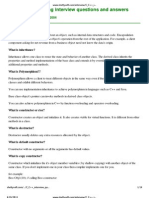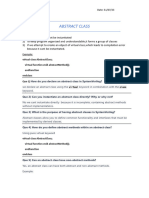0 ratings0% found this document useful (0 votes)
9 viewsPython(2)
Uploaded by
programmerakashpcCopyright
© © All Rights Reserved
We take content rights seriously. If you suspect this is your content, claim it here.
Available Formats
Download as PDF, TXT or read online on Scribd
0 ratings0% found this document useful (0 votes)
9 viewsPython(2)
Uploaded by
programmerakashpcCopyright
© © All Rights Reserved
We take content rights seriously. If you suspect this is your content, claim it here.
Available Formats
Download as PDF, TXT or read online on Scribd
You are on page 1/ 9
Python Revision Notes
1. Revision of Python Basics
Data Types:
o Integers (int): Whole numbers (e.g., -2, 0, 100)
o Floa ng-point numbers (float): Numbers with
decimal points (e.g., 3.14, -2.5)
o Strings (str): Sequences of characters enclosed in
single or double quotes (e.g., "Hello", 'Python')
o Booleans (bool): Represent truth values (True or
False)
Operators:
o Arithme c Operators: + (addi on), - (subtrac on), *
(mul plica on), / (division), % (modulo - remainder),
** (exponen a on), // (floor division)
o Rela onal Operators: > (greater than), < (less than),
>= (greater than or equal to), <= (less than or equal
to), == (equal to), != (not equal to)
o Logical Operators:1 and (logical AND), or (logical OR),
not (logical NOT)
o Assignment Operators: = (assign), += (add and
assign), -= (subtract and assign), etc.
Input/Output:
o input(): Reads a line of input from the user as a string.
o print(): Displays output to the console.
Type Conversion:
o int(): Converts a value to an integer.
o float(): Converts a value to a floa ng-point number.
o str(): Converts a value to a string.
Control Flow:
o Condi onal Statements:
if: Executes a block of code if a condi on is true.
elif: (else if) Executes a block of code if the
previous condi on(s) were false and this
condi on is true.
else: Executes a block of code if none of the
preceding condi ons were true.
o Loops:
for: Iterates over a sequence (e.g., a list, string, or
range of numbers).
while: Repeats a block of code as long as a
condi on is true.
2. Working with Data Structures
Lists:
o Ordered collec ons of items.
o Mutable (can be changed a er crea on).
o Defined using square brackets [].
o Example opera ons: append(), insert(), remove(),
pop(), sort(), reverse().
Tuples:
o Ordered collec ons of items.
o Immutable (cannot be changed a er crea on).
o Defined using parentheses ().
o O en used for storing related pieces of data.
Dic onaries:
o Collec ons of key-value pairs.
o Unordered.
o Mutable.
o Defined using curly braces {}.
o Keys must be unique and immutable (e.g., strings,
numbers, tuples).
o Example opera ons: accessing values by key, adding
new key-value pairs, upda ng values.
Sets:
o Unordered collec ons of unique items.
o Mutable.
o Defined using curly braces {} or the set() constructor.
o Useful for removing duplicates from a list or
performing set opera ons (union, intersec on,
difference).
3. String Manipula on
String Indexing and Slicing:
o Strings are indexed star ng from 0.
o Access individual characters using their index (e.g.,
my_string[0] for the first character).
o Extract substrings using slicing (e.g., my_string[1:4]
for characters at indices 1, 2, and 3).
String Methods:
o upper(): Converts the string to uppercase.
o lower(): Converts the string to lowercase.
o strip(): Removes leading and trailing whitespace. 2
o split(): Splits the string into a list of substrings based
on a delimiter.
o join(): Joins a list of strings into a single string using 3 a
delimiter.
o replace(): Replaces occurrences of a substring with
another substring.
o ...and many more!
String Forma ng:
o f-strings: Embed variables and expressions directly
within strings using curly braces {}. (e.g., f"My age is
{age}")
o format() method: Use placeholders {} in a string and
provide values to fill them using the format() method.
4. Func ons
Defining Func ons:
o Use the def keyword followed by the func on name,
parentheses for parameters, and a colon.
o The func on body is indented.
Func on Arguments and Parameters:
o Parameters are variables listed in the func on
defini on.
o Arguments are the actual values passed to the
func on when it's called.
Return Values:
o Use the return statement to send a value back from
the func on.
Scope of Variables:
o Local variables: Variables defined inside a func on
are only accessible within that func on.
o Global variables: Variables defined outside any
func on are accessible throughout the program.
5. File Handling
Opening and Closing Files:
o open(filename, mode): Opens a file in the specified
mode.
o file.close(): Closes the file.
File Modes:
o "r": Read mode (default).
o "w": Write mode (creates a new file or overwrites an
exis ng one).
o "a": Append mode (adds data to the end of an
exis ng file).
o "x": Create mode (creates a new file, but raises an
error if the file already exists).
o You can also add "b" for binary mode (e.g., "rb" for
reading a binary file).
Reading and Wri ng Data:
o read(): Reads the en re file content as a string.
o readline(): Reads a single line from the file.
o readlines(): Reads all lines from the file and returns
them as a list4 of strings.
o write(data): Writes data to the file.
6. Using Python Libraries
math module:
o Provides mathema cal func ons like sqrt(), sin(),
cos(), tan(), log(), ceil(), floor(), and more.
random module:
o Generates random numbers.
o random(): Returns a random float between 0.0 and
1.0.
o randint(a, b): Returns a random integer between a
and b (inclusive).
o choice(seq): Returns a random element from a
sequence (e.g., a list or tuple).
sta s cs module:
o Performs sta s cal calcula ons.
o mean(data): Calculates the mean (average) of a
dataset.
o median(data): Calculates the median of a dataset.
o stdev(data): Calculates the standard devia on of a
dataset.
7. Addi onal Topics (Depending on your curriculum)
Object-Oriented Programming (OOP):
o Classes: Blueprints for crea ng objects.
o Objects: Instances of classes.
o Inheritance: Crea ng new classes that inherit
proper es and methods from exis ng classes.
o Polymorphism: The ability of objects of different
classes to respond to the same method call in
different ways.
Excep on Handling:
o try: A block of code that might raise an excep on.
o except: Handles specific types of excep ons.
o finally: Code that always executes, regardless of
whether an excep on occurred.
Modules and Packages:
o Modules: Python files containing func ons, classes,
and variables that can be reused in other programs.
o Packages: Collec ons of related modules.
Database Connec vity:
o Using libraries like sqlite3 to connect to and interact
with databases (e.g., crea ng tables, inser ng data,
retrieving data).
You might also like
- Grade 6 - Handout On Python Programming 2023-24No ratings yetGrade 6 - Handout On Python Programming 2023-2412 pages
- CS201 1 To 18 Lechers by Pin and MuhammadNo ratings yetCS201 1 To 18 Lechers by Pin and Muhammad10 pages
- Project Report Industrial Training: DAV Institute of Engineering & Technology, JalandharNo ratings yetProject Report Industrial Training: DAV Institute of Engineering & Technology, Jalandhar24 pages
- Class XII CS-083 Important Points For Term-1 Sweeti KakhaniNo ratings yetClass XII CS-083 Important Points For Term-1 Sweeti Kakhani4 pages
- Lab Manual_ Week 1 - Programming for Artificial IntelligenceNo ratings yetLab Manual_ Week 1 - Programming for Artificial Intelligence8 pages
- Python Programming Basic Python: 1. Introduction To Python 5. LoopingNo ratings yetPython Programming Basic Python: 1. Introduction To Python 5. Looping3 pages
- Creating a Python script that covers everythingNo ratings yetCreating a Python script that covers everything5 pages
- Python for Data Science: Data Science Mastery by Nikhil Khan, #1From EverandPython for Data Science: Data Science Mastery by Nikhil Khan, #1No ratings yet
- CS8392 Object Oriented Programming MCQ PDFNo ratings yetCS8392 Object Oriented Programming MCQ PDF167 pages
- Ronali - Compiler - Design - Midsem - SolutionNo ratings yetRonali - Compiler - Design - Midsem - Solution23 pages
- Arith - Exp - Arithmetic Expressions - ABAP Keyword DocumentationNo ratings yetArith - Exp - Arithmetic Expressions - ABAP Keyword Documentation4 pages
- Binary Search Tree: Search Operation Insertion Operation Deletion OperationNo ratings yetBinary Search Tree: Search Operation Insertion Operation Deletion Operation12 pages

























































































